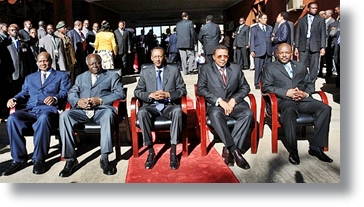EAC has Vast Opportunities for the Youth

 |
| EAC heads, committed to integration |
These were young people who were not engaged sufficiently enough to understand what elections are about and how to accept the results of such a process. They were young people who had no money to feed themselves or their families, and therefore hiring them using a mere Kenya Shillings 200 was enough to make them commit murder and theft.
According to the UN, 200 million people in Africa are youth (below 25 years) making over 25% of the population. This means that ignoring youth voices and needs is ignoring a quarter of the continent’s population that is responsible for carrying forward the mantle that will be left by the older generation.
Why am I being so negative and downcast about the youth and yet I refer to them as the future movers and shakers of the region? Well, I am not being negative, but realistic about what can happen when young impressionable people are confronted with life’s challenges of poverty, misinformation, and sidelining. The next big global innovation will come from the bright minds of the youth.
The world is changing...East Africa is changing...
Globalisation has become part and parcel of our daily lives whether we like it or not. The clothes we are wearing are a product of globalisation. The fabric was most likely sourced in Bangladesh or India or some sub-continent country in Asia. The design is developed in Europe or North America, and finally it is sewn and packaged in the Far East, most likely China. Thus, the most basic of things we take for granted are a product of a very complex production process made possible by globalisation.
Interdependence between countries, regions, and continents has always been around in various guises. Take colonialism for example. European countries depended on raw materials from colonies to fuel their industrialisation. More recently, think about how the financial crisis nearly crippled the whole world yet it began in the United States. Such is the level of interdependence among countries of the world.
Drivers and not passengers. For far too long, developing countries have been mere passengers in their own countries in terms of pushing the economic development and growth agenda. In the EAC, we are saying enough is enough. We are going to be masters of our own destiny. That is why we are embarking on the integration journey. This journey has the potential to see us grow to a middle income region and even perhaps, with the youth driving the process, a high income region.
Seeds sown, fruit being reaped. The integration process existed during the colonial period, just after until 1977. The process was reignited in 1993, and formalised in 2000. To date, we have what we call a customs union which allows the free movement of goods, and a common market which allows the free movement of the factors of production. Since 2005, we have seen trade within the region increase from US$1.8 billion in 2004 to US$3.3 billion in 2008. Foreign Direct Investment has also increased from US$690 million to over US$1.7 billion in 2009.
If we don’t shape up, we shall be shaped out. Although youth are grappling with lack of awareness on EAC integration, rural unemployment and underemployment, rural to urban migration, poverty, pregnancy, crime and limited access to current affairs, there are vast opportunities they can tap.
Opportunities
There are vast opportunities for youths in East Africa. The main entry point for the youth in the region is the common market. The liberalisation of services as well as free movement of persons and labour offers abundant opportunities for the youth to seek and exploit the regions’ wealth. The mutual recognition of education and professional qualifications offer students and professional the potential to study and ply their trade in five countries.
Youth ought to tap into information technology accruing from the proliferation of the fibre optic cable; Business outsourcing – skills to compete with other countries that have effectively used outsourcing as an engine to spur youth employment and wealth creation e.g. India; Professional Services – since the services sector in East Africa is booming at the moment and there is great demand for professional services; Small and medium business – since the establishment of the EAC Customs Union has provided for the free movement of goods within the region and education.
Having a skilled youthful workforce is vital for the successful and sustainable development of the region. It is therefore vital that there be right structures and institutions in place to support and develop this skilled workforce. East African governments are undertaking a number of initiatives to equip and engage the youth. Improving the business climate through trade facilitation and foreign direct investment has the potential to have a trickledown effect that the youth can tap into.
By David Nalo,
Permanent Secretary, Ministry of The East African Community, Kenya.
Excerpted from his presentation during The IREN Think Tank Forum for Youth on the East African Community
